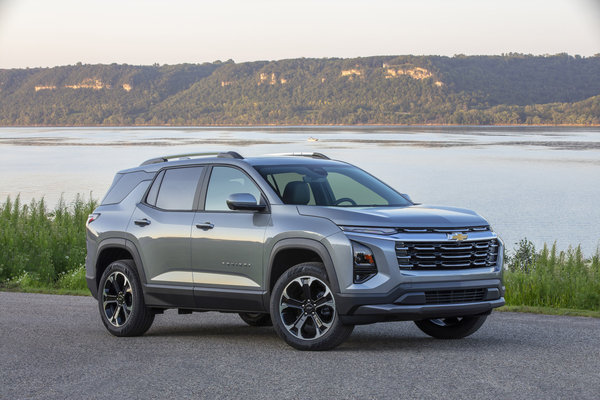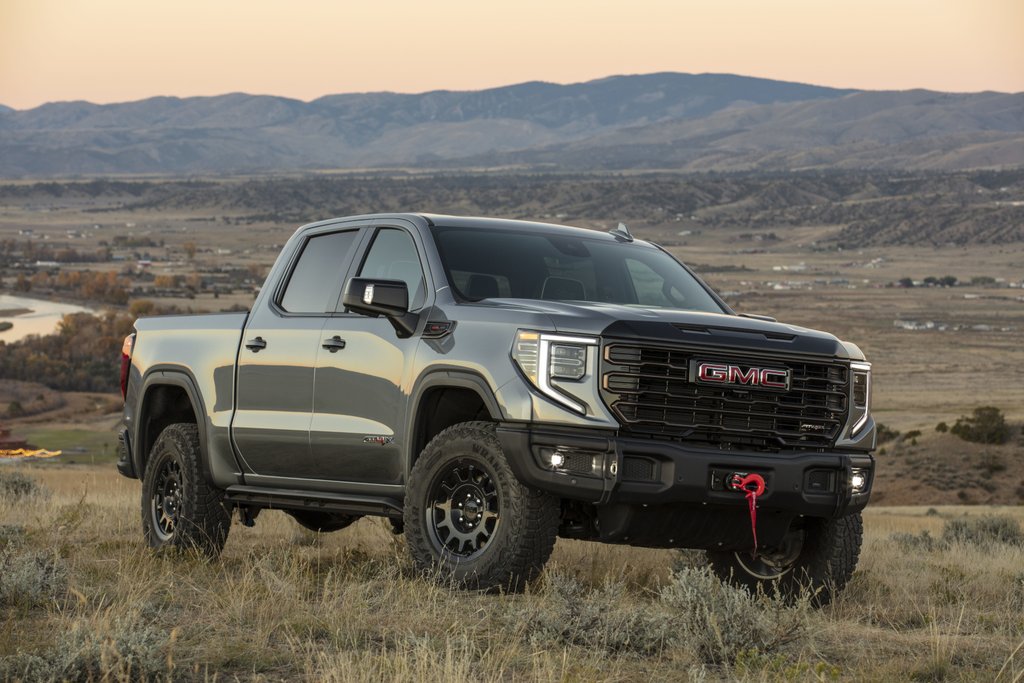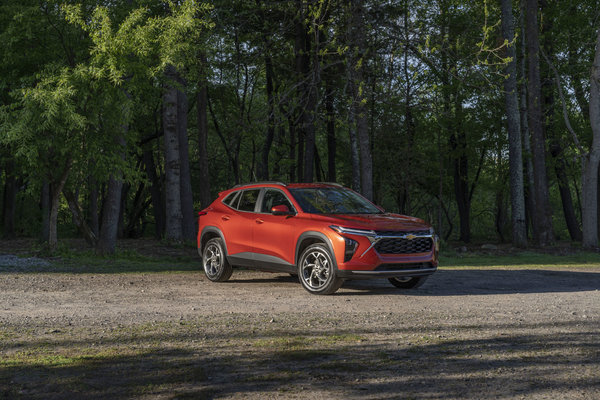
Preparing for Atlantic Weather: Why the 2025 Chevrolet Equinox's AWD Matters This Fall

Truck buyers in Nova Scotia want to know exactly what they're getting. Marketing terms like "off-road capable" or "adventure-ready" sound appealing, but they don't explain how specific components perform in real Maritime conditions. The 2025 GMC Sierra 1500 AT4 includes three features that directly address challenges Nova Scotia drivers face: Rancho monotube shocks, all-terrain tires, and Hill Descent Control.
These aren't luxury add-ons or styling choices. Each component serves a functional purpose related to the roads, terrain, and weather conditions around Amherst and throughout the Maritimes. Understanding what these features actually do helps you determine if the AT4 matches your driving requirements.
Rancho Monotube Shocks: Handling Road Damage and Rough Terrain
The AT4 comes equipped with Rancho monotube shocks as part of its 2-inch factory lift and off-road suspension package. Unlike standard shock absorbers, monotube design places all components in a single chamber, improving heat dissipation and response consistency.
How They Perform on Maritime Roads
Nova Scotia's roads take a beating each winter. Freeze-thaw cycles create potholes, frost heaves, and uneven pavement. By spring, many rural routes and secondary highways show significant damage. Standard shocks on most vehicles absorb these impacts, but repeated abuse leads to fluid breakdown and reduced damping performance.
Rancho monotube shocks handle harsh impacts without performance degradation. When you hit a pothole on Route 2 or navigate frost-damaged sections of rural Cumberland County roads, the monotube design maintains consistent damping force. The single-chamber construction prevents shock fade that occurs when fluid overheats from repeated compression.
The practical result: Your truck maintains control and stability over damaged roads. The suspension doesn't bottom out as easily, protecting both the vehicle and your cargo from jarring impacts.
Off-Road Applications
Beyond damaged pavement, the Rancho shocks excel on unpaved surfaces. Cottage roads, forestry trails, and farm access routes around Nova Scotia often feature deep ruts, exposed rocks, and uneven surfaces.
The monotube design responds quickly to terrain changes. When one wheel drops into a rut while the other stays elevated, the shocks adjust independently to maintain tire contact with the ground. This independent response keeps all four wheels working together for traction rather than allowing the suspension to bind or lose control.
All-Terrain Tires: Grip in Wet, Muddy, and Mixed Conditions
The AT4 rides on all-terrain tires designed for surfaces beyond dry pavement. These tires feature deeper tread patterns and more aggressive shoulder blocks than standard highway tires.
Tread Design and Water Evacuation
Maritime weather brings frequent rain from September through November. All-terrain tires include wide grooves that channel water away from the contact patch. When driving through standing water or across flooded sections of rural roads, these channels reduce hydroplaning risk by maintaining rubber-to-road contact.
The deeper tread depth also provides better grip on wet pavement. Standard tires lose effectiveness as tread wears down, but all-terrain tires maintain their wet-weather performance longer due to the extra tread depth from the factory.
Mud and Gravel Performance
If you access hunting properties, work sites, or seasonal camps in Cumberland County or elsewhere in Nova Scotia, you'll encounter mud and gravel regularly. All-terrain tires feature spacing between tread blocks that prevents mud from packing into the tire.
When mud packs into tire treads, the tire essentially becomes smooth, losing all traction. The self-cleaning design of all-terrain treads allows mud to escape as the tire rotates, maintaining grip even in slippery conditions.
On gravel roads, the aggressive shoulder blocks bite into loose material. This grip helps during acceleration and provides better control during braking compared to highway tires that slide over loose surfaces.
Winter Preparedness
While not classified as winter tires, all-terrain tires perform adequately in light snow conditions common in early winter or late fall around Amherst. The tread pattern provides more bite than standard tires when encountering the season's first snowfall.
For dedicated winter use, proper winter tires remain the better choice. However, the all-terrain tires on the AT4 handle transitional weather better than conventional highway rubber.
Hill Descent Control: Managing Slippery Descents
Hill Descent Control comes standard on the Sierra 1500 AT4 through the off-road package. This system uses the antilock braking system to maintain a controlled descent speed on steep, slippery slopes.
Boat Launch Applications
Nova Scotia's coastline includes numerous boat launches with steep, algae-covered ramps. Backing down these ramps during low tide exposes surfaces that become extremely slippery. Traditional braking on these surfaces can cause wheels to lock and slide.
Hill Descent Control applies braking to individual wheels, preventing lockup while maintaining steady downward speed. The system operates automatically once activated, allowing you to focus on steering and trailer positioning rather than managing brake pressure.
The same technology applies when pulling your boat out of the water. Climbing a slippery ramp requires consistent power delivery without wheel spin. The traction control system works with Hill Descent Control to manage power distribution, keeping the truck moving upward without losing grip.
Forestry Roads and Steep Property Access
Many properties around Cumberland County and rural Nova Scotia include steep driveways or access roads. After rain, these slopes become treacherous. Driving down a muddy incline typically requires careful brake modulation to prevent sliding.
Hill Descent Control removes the guesswork. The system maintains a preset crawl speed (approximately 5-8 km/h) while automatically adjusting brake pressure at each wheel. If one side of the truck encounters looser ground or standing water, the system compensates by applying more braking force to wheels with better traction.
This controlled descent prevents the common scenario where a truck gains momentum on a slippery slope and slides sideways or loses steering control.
How to Activate and Use
Hill Descent Control activates through a button on the centre console. Once engaged, the system takes over brake management at speeds below approximately 35 km/h. You maintain steering control and can adjust speed slightly using the accelerator or brake pedal, but the system prevents uncontrolled acceleration or wheel lockup.
The feature works in forward or reverse, making it useful for both descending challenging terrain and backing down boat ramps or steep driveways.
AT4 Trim: Complete Off-Road Package

These three features form part of the AT4's comprehensive off-road capability. The trim also includes:
The AT4 starts with the Duramax 3.0L Turbo-Diesel engine paired with a 10-speed automatic transmission, though other powertrain options are available.
AT4 Trim Breakdown
|
Feature |
What It Does |
Why It Matters in Nova Scotia |
|---|---|---|
|
Rancho monotube shocks |
Absorb impacts without performance loss |
Handle frost-damaged roads, potholes, rough terrain |
|
All-terrain tires |
Deeper tread, aggressive pattern |
Grip in rain, mud, gravel, early snow |
|
Hill Descent Control |
Automated brake control on descents |
Safe boat launches, steep property access |
|
2-inch factory lift |
Increased ground clearance |
Navigate ruts, flooded sections, uneven terrain |
|
Two-speed transfer case |
Low-range gearing |
Improved crawl control, better traction |
|
Underbody skid plates |
Protect undercarriage |
Shield from rocks, debris, trail obstacles |
Real-World Scenario: Coastal Property Access
Consider this common Nova Scotia situation: You own waterfront property accessed via a steep gravel driveway. The driveway runs downhill toward the water, and after heavy rain, the lower section becomes muddy and rutted.
Descending: You activate Hill Descent Control at the top of the driveway. The system maintains a controlled speed as you navigate down the slope. The Rancho shocks absorb impacts from exposed rocks and ruts. The all-terrain tires maintain traction in muddy sections without spinning or sliding sideways.
Ascending: Heading back up, the two-speed transfer case provides low-range gearing. The all-terrain tires bite into the loose gravel, and the traction control system prevents wheel spin. The Rancho shocks keep all four tires in contact with uneven surfaces, maximizing available grip.
Without these features, you might need to park at the top of the driveway and walk down, or risk sliding on the descent and getting stuck on the ascent.
Comparing AT4 to Base Sierra Trims
The base Pro and SLE trims of the Sierra 1500 use conventional suspension and highway tires. These configurations handle paved roads effectively but struggle with the scenarios described above.
Standard shocks provide adequate ride quality on smooth surfaces but lack the damping consistency for rough terrain. Highway tires prioritize fuel economy and quiet operation over traction in mud, gravel, or wet conditions. Without Hill Descent Control, managing steep, slippery slopes requires skill and experience that not all drivers possess.
The AT4 trim directly addresses these limitations with components designed for challenging conditions. The price premium reflects the specialized equipment, engineering, and testing that went into creating a truck that performs beyond typical suburban driving.
AT4X: The Next Level
GMC offers an AT4X trim that takes capability further with front and rear electronic locking differentials, Multimatic DSSV dampers, and AEV stamped steel bumpers with winch capability. These additions suit drivers who need maximum off-road performance for extreme terrain.
For most Nova Scotia driving—including boat launches, cottage roads, work sites, and rural property access—the standard AT4 provides the necessary capability without the additional cost of the AT4X package.
Powertrain and Towing
The AT4 offers multiple engine options, with the Duramax 3.0L Turbo-Diesel being a popular choice for its torque output and fuel efficiency. The diesel produces substantial low-end torque that proves useful for towing boats, work trailers, or recreational equipment.
Maximum towing capacity reaches 4,082 kg (9,000 lbs) when properly equipped. This capacity handles most boats, campers, and utility trailers common in Nova Scotia. The combination of diesel torque, all-terrain traction, and Hill Descent Control makes the AT4 well-suited for towing in challenging conditions.
Your New Sierra 1500 AT4 is Waiting
The 2025 GMC Sierra 1500 AT4 delivers functional off-road capability suited to Maritime driving conditions. Rancho monotube shocks handle damaged roads and rough terrain. All-terrain tires provide grip in rain, mud, and gravel. Hill Descent Control manages slippery descents safely and confidently.
These features work together to handle the real-world challenges Nova Scotia truck owners face—from navigating frost-damaged highways to accessing remote properties after heavy rain. Contact our sales team at Tantramar Chevrolet in Amherst to see the AT4 in person and discuss how its capabilities match your specific needs.
Other Articles That May Interest You

Preparing for Atlantic Weather: Why the 2025 Chevrolet Equinox's AWD Matters This Fall

3 Big-Car Technologies You Get Standard in the 2025 Chevrolet Trax

Trax or Trailblazer? Your Complete Guide to Chevrolet's Small SUV Lineup
